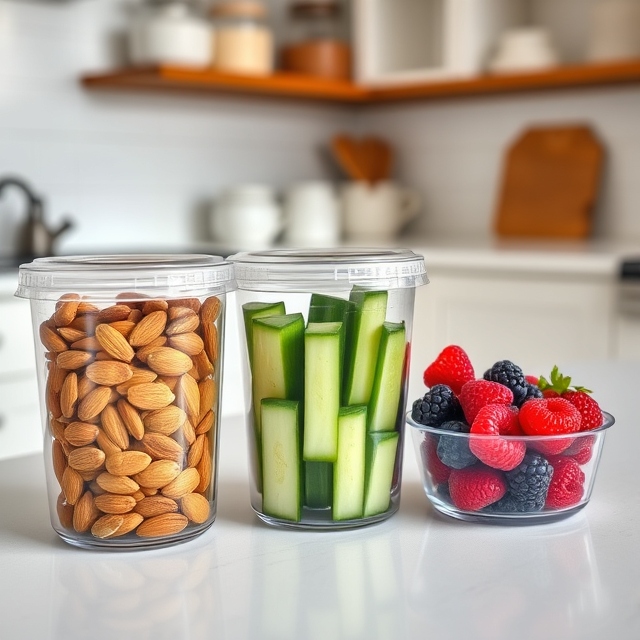The Secret to Losing 10 Pounds: How to Get Started with Portion Control
In the journey toward weight loss, one of the most powerful but often overlooked tools is portion control. While diets and exercise plans vary, mastering portion control helps manage calories effortlessly without restrictive dieting.

Let’s break down how you can use portion control as a manageable approach to shed pounds while making healthier choices.
Why Portion Control Matters
Portion control is about managing the quantity of food you eat, rather than focusing solely on cutting calories or avoiding specific food groups. By eating reasonable portions, you naturally consume fewer calories, which can create a calorie deficit, crucial for weight loss. Studies indicate that portion control is an effective strategy, especially for people who may struggle with restrictive diets, as it doesn’t force you to eliminate foods you enjoy.
How to Implement Portion Control in Your Daily Life
1. Start with Smaller Plates and Bowls Research shows that using smaller plates can trick the brain into thinking you’re consuming more than you actually are. This visual illusion can reduce calorie intake by up to 20%. By serving food on smaller dishes, you’ll naturally limit portions without feeling deprived.
2. Measure Your Servings Using measuring cups, food scales, or visual references helps develop a sense of what a healthy portion looks like. Here are some simple guidelines:
- A serving of protein (like chicken or fish) is roughly the size of your palm.
- A serving of carbs (like rice or pasta) should fit into a cupped hand.
- Vegetables can take up half your plate, providing nutrients without adding excessive calories.
3. Be Mindful When Eating Out Restaurant portions tend to be much larger than what’s typically needed. When dining out, consider splitting a meal with a friend, or ask for a to-go box upfront and save half for later. These tactics help avoid overeating and stay on track with portion control goals.
4. Avoid Eating Straight from the Package Mindless eating often happens when snacks are consumed straight from the package. Pour a single serving into a bowl to keep portions in check. This method makes it easier to monitor exactly how much you’re eating.
5. Listen to Your Body’s Hunger Cues Learning to differentiate between true hunger and emotional cravings is key. Eat slowly, and take breaks during meals to check in with how full you feel. Practicing mindful eating can prevent overeating, making portion control more effective.
Practical Tips for Maintaining Portion Control
Use Pre-Portioned Containers Pre-portioning meals and snacks can make it easier to avoid overeating, especially on busy days. Invest in containers that match the portions you’re aiming for. Many are labeled with specific serving sizes, simplifying the process.
Learn About Food Density Food density is the amount of calories relative to its weight. Low-density foods like fruits, vegetables, and whole grains offer larger portions with fewer calories. High-density foods, like cheese or nuts, should be eaten in smaller amounts. By focusing on low-density foods, you can enjoy larger portions that are naturally lower in calories.
Limit High-Calorie Condiments Condiments like dressings, oils, and sauces can quickly add extra calories. Use them sparingly or try alternatives, such as vinegar or lemon juice, to enhance flavors without overloading on calories.
Benefits of Portion Control Beyond Weight Loss
Portion control not only aids weight loss but also promotes healthier eating habits. When you become aware of portions, you tend to make more mindful choices and develop a healthier relationship with food. Over time, portion control can also help stabilize blood sugar levels, reduce digestive strain, and prevent bloating. Moreover, eating in moderation helps maintain energy throughout the day, improving focus and productivity.

Addressing Common Questions on Portion Control for Weight Loss
How Quickly Will I See Results? Weight loss results vary, but many people notice changes in 2-4 weeks. Remember, portion control isn’t an overnight solution. Consistency is key, and gradually, you’ll develop lasting habits.
Is Portion Control Effective Without Exercise? Portion control alone can lead to weight loss, but combining it with regular physical activity enhances results. Physical activity not only burns calories but also boosts your metabolism and supports overall health.
Can I Use Portion Control with Any Diet? Yes! Portion control is versatile and can be incorporated into any eating plan, whether you’re following a low-carb, plant-based, or Mediterranean diet. It simply involves being mindful of the amount you eat, allowing flexibility with food choices.
Practical Examples and Success Stories
Real-life stories illustrate the benefits of portion control. A study published in the American Journal of Clinical Nutrition found that participants who practiced portion control for six months reported an average weight loss of 10 pounds. Many cited the ease of integrating portion control into daily life compared to rigid diets.
Final Thoughts
Portion control is a sustainable and flexible method for achieving weight loss goals. By following these tips and strategies, you’ll create a balanced approach to eating that doesn’t feel restrictive. Instead, you’ll enjoy the foods you love while taking strides toward a healthier you. Whether your goal is to lose 10 pounds or maintain a healthy weight, mastering portion control offers a simple yet powerful solution.



